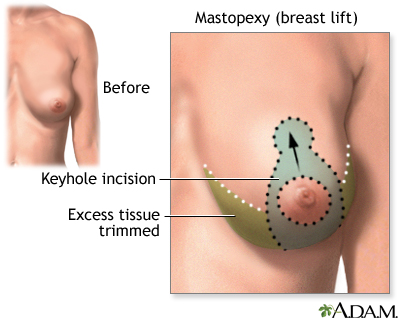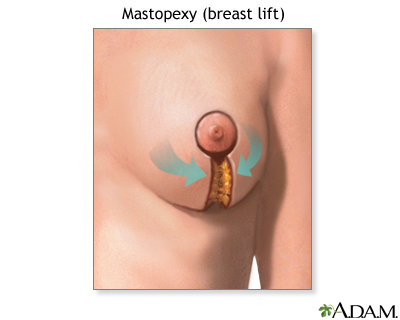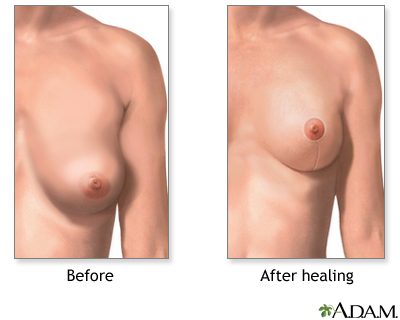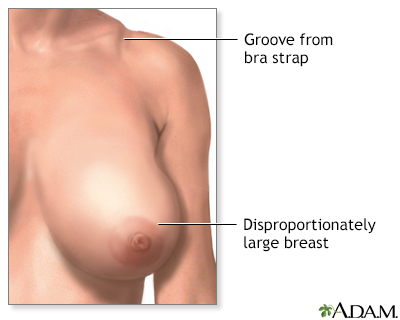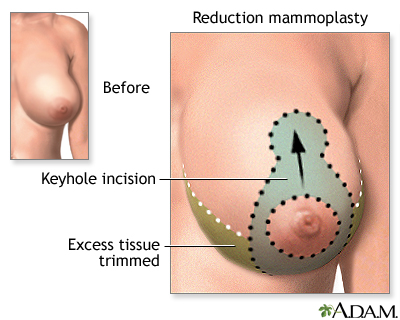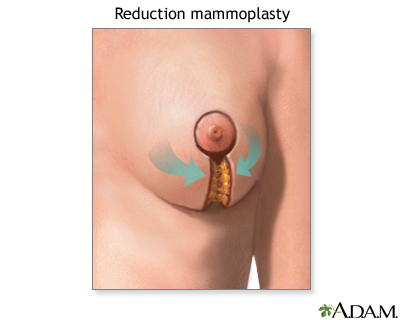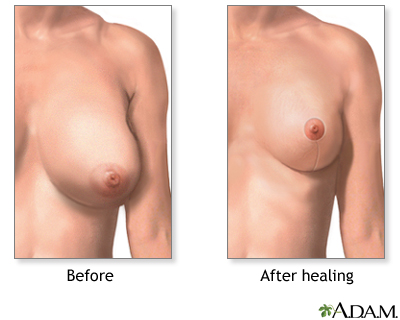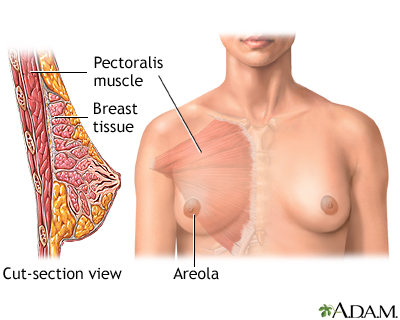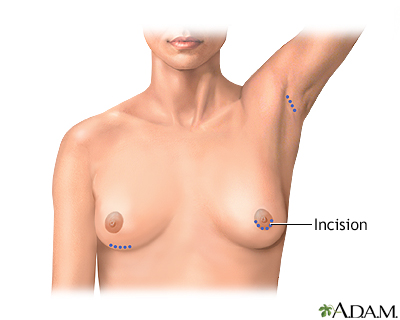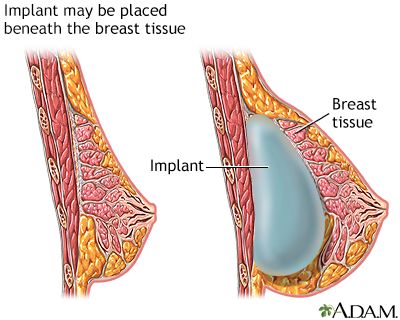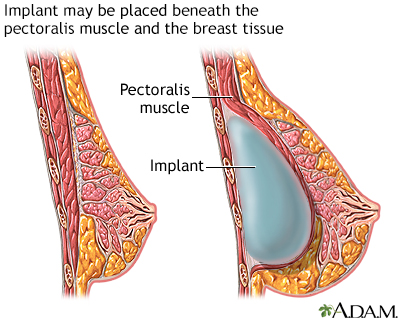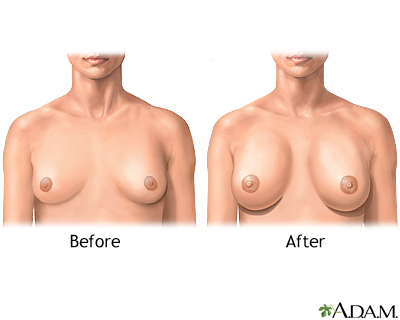Breast augmentation surgery
Breast augmentation; Breast implants; Implants - breast; Mammaplasty - augmentationBreast augmentation is a procedure to enlarge or change the shape of the breasts.
Description
Breast augmentation is done by placing implants behind breast tissue or under the muscle fascia, or chest muscle.
An implant is a sac filled with either sterile salt water (saline) or a material called silicone.
The surgery is done at an outpatient surgery clinic or in a hospital.
- Most women receive general anesthesia for this surgery. You will be asleep and pain-free.
- If you receive local anesthesia, you will be awake and will receive medicine to numb your breast area to block pain.
There are different ways to place breast implants:
- In the most common technique, the surgeon makes a cut (incision) on the underside of your breast, in the natural skin fold. The surgeon places the implant through this opening. Your scar may be a little more visible if you are younger, thin, have very small breasts, or have not had children.
- The implant may be placed through a cut under your arm. The surgeon may perform this surgery using an endoscope. This is a tool with a camera and surgical instruments at the end. The endoscope is inserted through the cut. There will be no scar around your breast. But, you may have a visible scar on the underside of your arm.
- The surgeon may make a cut around the edge of your areola. This is the darkened area around your nipple. The implant is placed through this opening. You may have more problems with breastfeeding and loss of sensation around the nipple with this method. There may be a higher risk of capsular contracture with this incision. Capsular contracture is when scar tissue causes the breast to become hard or misshapen.
- A saline implant may be placed through a cut near your belly button. An endoscope is used to move the implant up to the breast area. Once in place, the implant is filled with saline.
The type of implant, size of the implant, and implant surgery can affect:
- How much pain you have after the procedure
- The appearance of your breast
- The risk for the implant breaking or leaking in the future
- Your future mammograms -- additional views will be required to allow visualization
Your surgeon can help you decide which procedure is best for you.
Why the Procedure Is Performed
Breast augmentation is done to increase the size of your breasts. It may also be done to change the shape of your breasts or to correct a defect you are born with (congenital deformity).
Talk with a plastic surgeon if you are considering breast augmentation. Discuss how you expect to look and feel better. Keep in mind the desired result is improvement, not perfection.
Risks
Risks for anesthesia and surgery in general are:
- Reactions to medicines, breathing problems
Breathing problems
Breathing difficulty may involve:Difficult breathing Uncomfortable breathingFeeling like you are not getting enough air
 ImageRead Article Now Book Mark Article
ImageRead Article Now Book Mark Article - Bleeding, blood clots, infection
Bleeding
Bleeding is the loss of blood. Bleeding may be:Inside the body (internal)Outside the body (external)Bleeding may occur:Inside the body when blood le...
 ImageRead Article Now Book Mark Article
ImageRead Article Now Book Mark ArticleBlood clots
Blood clots are clumps that occur when blood hardens from a liquid to a solid. A blood clot that forms inside one of your veins or arteries is calle...
 ImageRead Article Now Book Mark Article
ImageRead Article Now Book Mark Article
Risks for breast surgery are:
- Difficulty breastfeeding
- Loss of feeling in the nipple area or surrounding skin
- Small scars, often in an area where they do not show much
- Thickened, raised scars
- Uneven position of nipples
- Different sizes or shapes of the two breasts
- Breaking or leakage of the implant
- Visible rippling of the implant
- Removal of implant due to an infection
- Need for more breast surgery
- Puncture of the lung
It is normal for your body to create a capsule made up of scar tissue around your new breast implant. This helps keep the implant in place. Sometimes, this capsule becomes thickened and larger. This may cause a change in the shape of your breast, hardening of breast tissue, or some pain.
Emotional risks for this surgery may include feeling that your breasts do not look perfect. Or, you may be disappointed with people's reactions to your new breasts.
There are some risks that may occur months or even years after an implant is in place.
A rare type of lymphoma (cancer of the immune system) has been reported with some types of implants. It is called breast implant-associated lymphoma. Symptoms include a mass or swelling around the implant and breast pain. It can be treated with removal of the implant and the area around the implant. Ongoing research in this area may discover other uncommon links between breast implants with other types of cancer.
Cancer
Cancer is the uncontrolled growth of abnormal cells in the body. Cancerous cells are also called malignant cells.

Some people have experienced systemic symptoms after receiving implants. This has been called breast implant illness although there is not enough evidence yet for it to be a recognized illness. Some refer to it as breast implant sensitivity. Reported symptoms include:
- Fatigue
- Memory and concentration problems (brain fog)
- Pain in joints and muscles
- Anxiety
- Hair loss
- Depression
Depression
Depression may be described as feeling sad, blue, unhappy, miserable, or down in the dumps. Most of us feel this way at one time or another for shor...
 ImageRead Article Now Book Mark Article
ImageRead Article Now Book Mark Article - Rash
- Autoimmune diseases
Autoimmune diseases
An autoimmune disorder occurs when the body's immune system attacks and destroys healthy body tissue by mistake. There are more than 80 autoimmune d...
 ImageRead Article Now Book Mark Article
ImageRead Article Now Book Mark Article - Inflammation
- Weight gain or loss
Some women report that symptoms improve after the implant is removed. Others do not. Despite these rare risks, breast implants are considered safe.
Before the Procedure
Ask your surgeon if you need a screening mammogram based on your age and risk of having breast cancer. This should be done long enough before surgery so if more imaging or a biopsy is needed, your planned surgery date won't be delayed.
Mammogram
A mammogram is an x-ray picture of the breasts. It is used to evaluate some breast symptoms and to find breast cancer in women with no symptoms (cal...

Tell your surgeon or nurse if:
- You are or could be pregnant
- You are taking any medicines, including medicines, drugs, supplements, or herbs you bought without a prescription
Planning for your surgery:
- If you have diabetes, heart disease, or other medical conditions, your surgeon may ask you to see your health care provider who treats you for these conditions.
Diabetes
Diabetes is a long-term (chronic) disease in which the body cannot regulate the amount of sugar in the blood.
 ImageRead Article Now Book Mark Article
ImageRead Article Now Book Mark ArticleHeart disease
Coronary heart disease is a narrowing of the blood vessels that supply blood and oxygen to the heart. Coronary heart disease (CHD) is also called co...
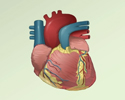 ImageRead Article Now Book Mark Article
ImageRead Article Now Book Mark Article - If you smoke, it's important to cut back or quit. Smoking can slow healing and increase the risk for blood clots. Your surgeon may postpone surgery if you continue to smoke. Ask your provider for help quitting smoking.
Smoking can slow healing and increase t...
Quitting smoking and other nicotine products, including e-cigarettes, before surgery can improve your recovery and outcome after surgery. Most people...
 ImageRead Article Now Book Mark Article
ImageRead Article Now Book Mark ArticleQuitting smoking
There are many ways to quit smoking. There are also resources to help you. Family members, friends, and co-workers may be supportive. But to be su...
 ImageRead Article Now Book Mark Article
ImageRead Article Now Book Mark Article - If needed, prepare your home to make it easier to recover after surgery.
Prepare your home
Getting your home ready after you have been in the hospital often requires some preparation. Set up your home to make your life easier and safer when...
Read Article Now Book Mark Article - Arrange for someone to drive you home after surgery and help you around the house for 1 or 2 days.
During the week before your surgery:
- You may be asked to temporarily stop taking medicines that keep your blood from clotting. These medicines are called blood thinners. This includes over-the-counter medicines and supplements such as aspirin, ibuprofen (Advil, Motrin), naproxen (Aleve, Naprosyn), and vitamin E. Many prescription medicines are also blood thinners.
- Ask your surgeon which medicines you should still take on the day of surgery.
On the day of the surgery:
- Follow instructions about when to stop eating and drinking.
- Take the medicines your surgeon told you to take with a small sip of water.
- Follow instructions on when to arrive at the hospital. Be sure to arrive on time.
After the Procedure
You will likely go home when the anesthesia wears off and you can walk, drink water, and get to the bathroom safely.
After breast augmentation surgery, a bulky gauze dressing will be wrapped around your breasts and chest. Or, you might wear a surgical bra. Drainage tubes may be attached to your breasts. These will be removed within 3 days. Your surgeon will give you instructions about when you may bathe or shower.
Your surgeon may also recommend massaging the breasts starting 5 days after surgery. Massaging helps reduce hardening of the capsule that surrounds the implant. Ask your provider first before massaging over your implants.
Outlook (Prognosis)
You are likely to have a very good outcome from breast surgery. You may feel better about your appearance and yourself. Also, any pain or skin symptoms due to the surgery will likely disappear. You may need to wear a special supportive bra for a few months to reshape your breasts.
Scars are permanent and are often more visible in the year after surgery. They may fade after this. Your surgeon will try to place the incisions so that your scars are as hidden as possible.
Tests may be recommended in the future to make sure the implants are not ruptured.
References
American Board of Cosmetic Surgery website. Breast augmentation (breast implants) guide. www.americanboardcosmeticsurgery.org/procedure-learning-center/breast/breast-augmentation-guide/. Accessed February 27, 2025.
Padilla PL, Khoo KH, Ho T, Cole EL, Sirvent RZ, Philips LG. Plastic surgery. In: Townsend CM Jr, Beauchamp RD, Evers BM, Mattox KL, eds. Sabiston Textbook of Surgery. 21st ed. St Louis, MO: Elsevier; 2022:chap 69.
Randquist C. Primary breast augmentation with implants. In: Nahabedian MY, ed. Plastic Surgery, Volume 5: Breast. 5th ed. Philadelphia, PA: Elsevier; 2024:chap 3.
US Food and Drug Administration website. Medical device reports for systemic symptoms in women with breast implants. www.fda.gov/medical-devices/breast-implants/medical-device-reports-systemic-symptoms-women-breast-implants. Updated February 6, 2025. Accessed February 25, 2025.
US Food and Drug Administration website. Risks and complications of breast implants. www.fda.gov/medical-devices/breast-implants/risks-and-complications-breast-implants. Updated December 14, 2023. Accessed February 25, 2025.
Breast lift (mastopexy) - series - Incisions
Presentation
Breast reduction (mammoplasty) - series - Indications
Presentation
Breast augmentation - series - Normal anatomy
Presentation
Review Date: 2/17/2025
Reviewed By: David A. Lickstein, MD, FACS, specializing in cosmetic and reconstructive plastic surgery, Palm Beach Gardens, FL. Review provided by VeriMed Healthcare Network. Also reviewed by David C. Dugdale, MD, Medical Director, Brenda Conaway, Editorial Director, and the A.D.A.M. Editorial team.




